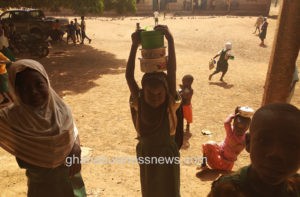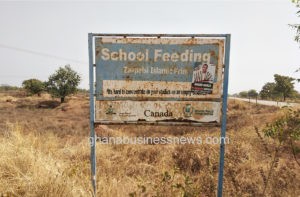Poor quality food, stark malnutrition in children of Mion District, despite school feeding programme

It was past 10:00am the morning we visited; and the children looked excited as they play on the school grounds, giggling, smiling, running and chatting. They were carrying and flaunting their bowls around; some plastic, some metallic. They have just finished eating the meal for the day. They are the few lucky ones in the Mion District whose basic school is on the Ghana School Feeding Programme. At least they get one meal a day, whenever food is available and it is prepared, but the quality of the food is questionable. And for the children who don’t eat at home before they head to school, the school meal is likely to be their only meal for the day, and yet it contains no animal protein of any kind.
“Since they started this school feeding programme here, I have never seen the children eat an egg or meat,” one teacher said. The headteachers and teachers we met, were unwilling to speak on the record, especially on the school feeding programme, because, they said they feared they would be victimized if they did, we therefore, decided not to put out their names.
While the children play and mingle, some of them visibly carry the signs of malnutrition. The few children from deprived homes, for whom this one meal a day should mean a lot, don’t seem to be deriving much in terms of the benefits of eating nutritious meals, because the meals are not – they have brown hair and protruding stomachs.
Most of the children from kindergarten to primary six; are aged between two and 17 years. Nutritionists suggest that nutrition for growing children is important. Children, just like adults, need nutrients – such as vitamins, minerals, carbohydrates, protein and fat. But children need different amounts of specific nutrients at different ages.
When we contacted some nutritionists for their expert comments on the nutrition requirements for children, they declined to comment when we told them we were looking at the school feeding programme. They told us they were uncomfortable speaking on the subject because the programme has been politicized.
Ghanabusinessnews.com investigations in some basic schools in the Mion District of the Northern Region, found that in addition to poor learning environments, lack of learning materials and inadequate chairs and desks, the quality of food that the children are being fed under the Ghana School Feeding Programme is poor and lacks the required nutrients.
The caterers choose what to cook for the children, we learned, even though there is a menu, it doesn’t appear they  follow the menu. While some teachers we spoke to said the cost of the meal each child is fed is GH¢3, a source working with the Programme says it is GH¢1 per child. The teachers also say the food is not sufficient to fill the children. And when there is no water or cooking oil, caterers do not cook and the children would have no food to eat. Those who have food at home, leave the school to get a bite at home.
follow the menu. While some teachers we spoke to said the cost of the meal each child is fed is GH¢3, a source working with the Programme says it is GH¢1 per child. The teachers also say the food is not sufficient to fill the children. And when there is no water or cooking oil, caterers do not cook and the children would have no food to eat. Those who have food at home, leave the school to get a bite at home.
Some teachers have identified some children who are not fed from home, who come to school starving, and these children, they say are unable to absorb the lessons while they teach.
Another headteacher said when the programme was directly under the World Food Programme, it was better managed.
The Mion District
 The Mion District was carved out of the Yendi District in 2012. The District with its capital Sang was created because the government argued, that it would make it easier to take development to the people. But almost seven years after the creation of the district, the quality of school buildings and other facilities does not tell a good story of development.
The Mion District was carved out of the Yendi District in 2012. The District with its capital Sang was created because the government argued, that it would make it easier to take development to the people. But almost seven years after the creation of the district, the quality of school buildings and other facilities does not tell a good story of development.
Dilapidated school buildings are common, and most don’t have furniture, compelling the children to sit on the floor during school hours.
Ghanabusinessnews.com, learned that there are 66 schools in the district and 17 are on the Ghana School Feeding Programme.
In Zakpalsi, one of the communities we visited, there are three schools – we visited two of them, Zakpalsi Insanniya and Zakpalsi Islamic School. The Islamic school is the only one signed onto the feeding programme, and so children from the other schools, sometimes go over when it is time to serve the meals – and they are served.
Insanniya has 175 pupils and Islamic has 276. The feeding programme at the Islamic school is one of the motivating factors for the children to attend school. With the GH¢900 Capitation Grant covering two terms, the authorities at the schools invest in whatever essential item, including books, that they can afford to complement the teaching and learning situation. With no chairs in most of the classrooms, most of the children sit on sandy floors to learn – as they do, they are covered in dirt.
Chegu AME Primary School, is one of the unlucky schools. The school has no feeding programme. School authorities  say they have applied for the programme and after a year, they haven’t heard from the Programme Secretariat. The children have no food to eat. “When they get hungry, they start leaving before school closes,” a teacher said.
say they have applied for the programme and after a year, they haven’t heard from the Programme Secretariat. The children have no food to eat. “When they get hungry, they start leaving before school closes,” a teacher said.
The Kpalkwal Primary School with 199 pupils is signed up to the feeding programme, but on the day we visited the school, the children didn’t eat, as the cook couldn’t prepare meals because there was no oil. Despite the challenges, and the inadequacy of learning materials, learning outcomes at this school, the teachers say, have increased from 20 to 80 per cent with increasing attendance.
The Jimle AME Zion Primary School is signed up to the feeding programme, but authorities are dissatisfied with the quality and quantity of food that the children are fed. They suggest it could be improved. “The children complain about eating the same food every day. There is no meat, fish or egg and whenever there is no water the cooks are unable to cook, and there won’t be food for the children,” one teacher said.
Undernutrition among children in Ghana
Considering the prevalence of undernutrition, the country has a national policy which identifies the problem and lays out the strategy to address it.
The Ghana national nutrition policy set to cover the period 2013 to 2017 analysing the current situation of undernutrition of children cites the country’s position on the Human Development Index. Ghana ranks 135 out of 187 countries and is included in the list of countries having the highest burden of malnutrition in the world. The policy additionally cites the 2008 Lancet series on maternal and childhood undernutrition which classified Ghana among the 36 countries in the world with the highest burden of chronic childhood undernutrition.
It further states that undernutrition remains a major developmental challenge in Ghana.
It is characterised by significant variations in stunting, underweight, and wasting across wealth quintiles and geographic regions and has been recognised in the national health policy and other relevant documentation, it says, adding that the three northern regions (Upper East, Upper West, and Northern) as well as the Central Region have the highest rates of stunting and wasting; these rates are linked closely to food insecurity situation in these areas.
“The national prevalence of stunting has remained persistently high and has seen very little reduction over the last two decades— having reduced from 34 per cent in 1988 to 28 per cent in 2008,” the policy states.
Having identified the problem, the policy sets out four objectives to address it: It would promote optimal nutrition as an essential component of health and development among all people living in Ghana; Increase access to and create demand for quality and timely interventions, for effective management of priority nutrition problems in Ghana; Promote food security, food quality, and food safety at the individual, household, community, and national levels, and create an enabling environment for the effective co-ordination, integration, and implementation of nutrition programmes in Ghana.
Ghana loses $2.6b to effects of child undernutrition
Child undernutrition costs the country. Despite all the efforts to address undernutrition, an African Union Commission led report issued in August 2016 says the economy of Ghana is losing some GH¢4.6 billion, approximately $2.6 billion, or 6.4 per cent of GDP every year to the effects of child undernutrition.
The report known as the Cost of Hunger in Africa: the Social and Economic Impact of Child Undernutrition on Ghana’s Long-Term Development (COHA), shows vast amounts being lost through rising healthcare costs, additional burdens on the education system and lower productivity by Ghana’s workforce.
It further noted the consequences of stunting (low height for age) as being of particular concern.
The authors of the report indicated among other things they found that 37 per cent of the adult population in Ghana suffered from stunting as children; 24 per cent of all child mortality cases in the country are associated with undernutrition, and child mortality associated with undernutrition has reduced Ghana’s workforce by 7.3 per cent. These findings essentially should make undernutrition a major issue requiring far more urgent attention.
The Ghana School Feeding Programme
 The programme was started in the year 2005 as a social protection intervention in the context of the Comprehensive African Agricultural Development Programme (CAADP) Pillar III and in response to the first and second Millennium Development Goals (MDGs). In addition to providing nutritious meals to school children, especially children from deprived communities, it was also set to offer jobs to caterers and cooks, as well as provide a market for small-holder farmers around the country.
The programme was started in the year 2005 as a social protection intervention in the context of the Comprehensive African Agricultural Development Programme (CAADP) Pillar III and in response to the first and second Millennium Development Goals (MDGs). In addition to providing nutritious meals to school children, especially children from deprived communities, it was also set to offer jobs to caterers and cooks, as well as provide a market for small-holder farmers around the country.
Entering the 14th year, the programme is required to provide one hot and adequately nutritious meal to 1.7 million pupils.
There are similar programmes around the world where over 370 million children in about 131 countries are served meals at school through national systems.
Budgetary allocation
In the 2018 budget, the government allocated GH¢468.5 million to the Ghana School Feeding Programme.
Selection criteria for schools and caterers
In spite of the good intentions of the proponents of the programme, it has been enveloped in controversies, scandals and partisan politics. Major concerns of the public has been the selection processes for the schools and caterers.
A 2018 document of the Programme has outlined the criteria for selecting schools and caterers, it doesn’t appear to be the case that the laid down criteria for selections are being followed.
According to the Programme’s own criteria, schools are selected when communities are willing to provide basic infrastructure such as a kitchen, storeroom, laterines, and to contribute in cash or in kind. The District Assembly must show commitment toward the programme as well as readiness and interest towards sustaining it. The poverty index by the Ghana Living Standard Survey data and the National Development Planning Commission poverty mapping are looked at. The other factors that are considered before a school is selected also include Low school enrolment and or attendance rate and gender parity index; High drop –out rate; Low literacy levels; Presence or planned provision/expansion of health and nutrition interventions; Communities /school not already covered by other feeding programmes; Poor access to potable water; High communal spirit and or community management capability.
When it comes to the selection of caterers for the programme, it is an open secret that it has been hijacked by political actors who dole it out to their cronies as rewards for helping them to win an election. After every election cycle, already contracted caterers by the previous government are hounded out and the contract given to party loyalists, family and friends of parties forming the new government.
Due to the partisan nature of the selection of caterers, the programme continues to suffer. For instance, caterers contracted to provide services to schools receive training along the line on how to prepare nutritious meals for the children. But when they are changed, the programme tends to lose out on their expertise and the competences that they have acquired over the period of their service.
“We train the caterers in how to prepare nutritious meals, but once they are changed when a different party comes into power, we lose all the skills, and the quality of food suffers,” says Ubaida Ibrahim of the Ghana Development Communities Association, who is also the Coordinator for E-For Life for Mion.
She also suggested that it is imperative for Civil Society Organisations and the Ministry of Health to work together to train the caterers regularly towards improving nutrition for the children.
Incidents of fraudulent payments and inflation of enrolment figures
On December 13, 2018, the Ministry of Gender, Children and Social Protection issued a directive ordering the National Coordinator of the Ghana School Feeding Programme, Dr. Kwame Adu-Nsiah to step aside while an investigation is carried out against his outfit for alleged fraudulent deals.
Making reference to a letter from National Security, the Ministry said the Programme has been accused of paying monies to caterers who have not been assigned to any school by the outfit.
The Coordinator is being accused of inflation of enrolment figures of some schools under the programme, including giving catering contracts for some schools which do not exist.
The Ministry noted further that fictitious caterers are reported to have been paid a total of GH¢141, 075 for the third term of 2017/2018 academic year. Others were identified to be involved in the ongoing malfeasance with non-existing schools assigned to them as well as inflation of enrolment figures of some schools under the Programme compared to the figures of the Ghana Education Service for the 2017/2018 academic year.
The Ministry asked Dr. Adu-Nsiah to prepare handing-over notes and hand over to his deputy by close of Friday, December 14, 2018, as it has been tasked to conduct an independent investigation into the above and take the appropriate action. The investigation is ongoing.
Responsible management of the Programme
If the Programme is managed in an accountable and responsible manner with a long term commitment to raising the next generation of the country’s leaders, the set broad and specific policy objectives of the Programme, which were that the school feeding efforts would improve school enrolment, attendance and retention among pupils in the most deprived communities in the country; promote an increase in domestic food production and consumption; increase the incomes of poor rural households; and improve the health and nutritional status of the pupils, would be achieved.
A written request to the Ghana School Feeding Programme to interview any proper officer hasn’t been responded to.
By Emmanuel K. Dogbevi
Copyright ©2019 by Creative Imaginations Publicity
All rights reserved. This report or any portion thereof may not be reproduced or used in any manner whatsoever without the express written permission of the publisher except for the use of brief quotations in reviews.
